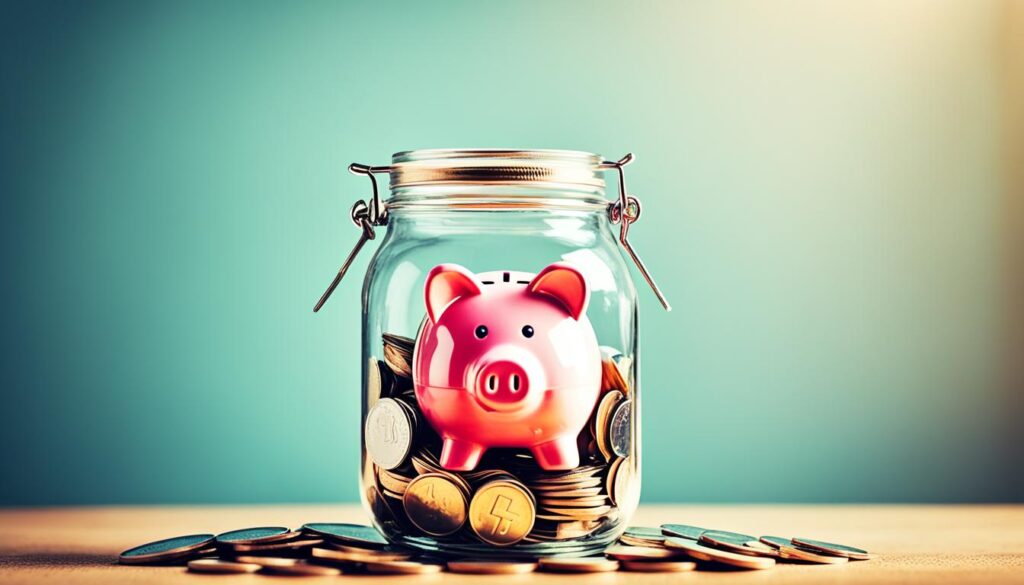Did you know that 43% of U.S. adults with credit card debt cite emergency or unexpected expenses as the main reason they carry that debt month to month1? This eye-opening statistic highlights a common financial dilemma faced by many Americans: should one prioritize paying off credit card debt, or focus on building emergency savings? In a landscape where only 44% of Americans can comfortably cover an unexpected expense of $1,000 or more from their savings, the stakes are high1. With financial planning being essential in navigating personal finance strategies, understanding how to balance emergency savings vs. paying off credit card debt is crucial.
In this article, we will dive deeper into the nuances of this ongoing challenge and help you determine the best approach for your unique financial situation.
Key Takeaways
- 43% of Americans with credit card debt claim emergencies contribute to their financial burden.
- Only 44% of people can manage an unexpected expense of $1,000 or more from their savings.
- 36% of individuals carry credit card debt that exceeds their available emergency savings.
- Emphasizing the need for a robust financial planning strategy can alleviate future debt.
- Understanding the balance between savings and debt repayment is essential for personal financial health.
Understanding Credit Card Debt
Credit card debt can significantly impact an individual’s financial well-being. This debt arises when consumers utilize credit cards to make purchases without paying off the full balance each month. The outstanding balance, combined with interest charges, creates a complex repayment scenario, especially when high-interest rates are involved. In February 2023, the average credit card interest rate soared to 20.09%, a drastic increase from 14.56% just a year prior2. Such rates can lead to an accumulation of debt rapidly, making money management even more crucial for consumers.
What is Credit Card Debt?
Credit card debt refers to the total amount owed by cardholders to credit card companies. Most credit cards feature double-digit interest rates, often making it more difficult for individuals to pay down their balances3. Financial experts suggest that maintaining a credit utilization rate of 30% or less is vital for a healthy credit score2. This can be particularly challenging for those already saddled with debt, as many households struggle to save while managing their monthly expenses.
Impact of High-Interest Rates
High-interest rates significantly hinder efforts to pay off credit card debt. For example, prolonging the repayment process can lead to thousands of dollars in interest charges over time4. In many cases, consumers may pay less than 1% APY in a high-yield savings account while facing an average credit card interest rate of around 16.43%4. Debt consolidation options, such as balance transfer offers with 0% APR promotional periods, can provide relief by allowing individuals to tackle their debt more efficiently4.

Understanding these dynamics is essential for anyone navigating the complexities of credit card debt. Effective strategies should combine awareness of interest rates with solid money management practices, enabling cardholders to work toward financial freedom.
| Credit Card | Promotional APR | Standard APR |
|---|---|---|
| U.S. Bank Visa® Platinum Card | 0% for 18 billing cycles | 18.74% – 29.74% |
| Citi Simplicity® Card | 0% for 21 months on balance transfers | 19.24% – 29.99% |
“A high-interest savings account is suggested for saving emergency funds.”3
Importance of Emergency Savings
An emergency fund is a crucial component of personal finance, providing a safety net for unforeseen expenditures. This fund can help prevent individuals from incurring credit card debt during challenging times, such as medical emergencies or significant repairs. Establishing a robust emergency fund is essential for financial preparedness. Experts recommend saving an initial amount of $500 and ultimately aiming for three to six months’ worth of living expenses in a high-yield savings account, which ideally offers competitive APY rates between 4.00% and 5.50%5. Without adequate savings, many individuals may struggle with their savings priorities, leaving them financially vulnerable.
What is an Emergency Fund?
An emergency fund serves as a financial buffer, allowing individuals to address unexpected costs without relying on high-interest credit options. A significant number of Americans report discomfort with their emergency savings levels; 59% do not feel secure with the amount saved6. Moreover, 27% of U.S. adults have no emergency savings at all, the highest percentage recorded since 20206. Establishing such a fund should be a fundamental strategy for anyone aiming to achieve greater financial stability.
Expected Expenses and Financial Preparedness
Understanding expected expenses is vital for effective financial planning and preparedness. Research indicates that around 89% of Americans believe they would need at least three months’ worth of expenses saved to feel comfortable during financial emergencies6. Furthermore, 36% of U.S. adults reported having more credit card debt than money in their emergency savings accounts in both 2023 and 20246. This reinforces the necessity of establishing an emergency fund, where individuals prioritize setting aside savings for potential crises.

| Statistics | Percentage |
|---|---|
| U.S. adults that feel uncomfortable with their savings | 59% |
| Adults with no emergency savings | 27% |
| Adults who believe they need at least three months saved | 89% |
| Adults with more credit card debt than savings | 36% |
| Households with income under $50,000 with no emergency savings | 46% |
The establishment of an emergency fund not only alleviates financial stress during emergencies but also supports overall financial wellness. By focusing on savings priorities, individuals can enhance their financial preparedness and resilience against unanticipated challenges7.
Emergency Savings vs. Paying Off Credit Card Debt
Determining the best approach for emergency savings vs. paying off credit card debt requires careful consideration of personal financial situations. Individuals must balance their priorities effectively, particularly if they are managing high-interest debt that could escalate rapidly. Assigning a portion of income to both savings and debt repayment is critical for achieving long-term financial goals.
Balancing Priorities in Personal Finance
Expert recommendations often suggest saving 20% of income monthly is ideal8. An emergency fund should ideally encompass three to six months’ worth of essential living expenses9. Furthermore, an initial savings target of around $1,000 can provide a safety net for unforeseen circumstances. Consumers can save significantly on interest by allocating more income toward paying off high-interest credit card debt rather than just focusing on building savings. Finding the right debt reduction strategy is essential, especially prioritizing high-interest debts that could hinder financial stability.
Statistics on Debt and Savings among Americans
Recent studies reveal that 36% of Americans possess more credit card debt than savings, highlighting the urgent need for effective financial strategies8. Even though the average recommendation is to have three to six months of expenses covered, many individuals are falling short. About 25% of people prioritize solely paying down debt, while a significant 36% attempt to balance saving with debt repayment9. Refinancing options can also help individuals manage payments more effectively, reducing high-interest burdens.
| Statistic | Value |
|---|---|
| Recommended Monthly Savings | 20% of income |
| Initial Emergency Fund Goal | $1,000 (approx. 1 month living expenses) |
| Emergency Fund Duration | 3-6 months of expenses |
| Percentage of Americans with More Debt than Savings | 36% |
| Percentage Focusing on Repayment | 25% |
| Percentage Balancing Saving and Repayment | 36% |
When to Focus on Building Savings
Making informed decisions about financial planning is crucial, particularly when weighing whether to concentrate on building savings or paying off low-interest debt. Understanding the implications of each choice can lead to improved money management and long-term financial stability.
Low-Interest Debt Considerations
For individuals with low-interest debt, resources often suggest turning attention towards establishing an emergency fund. This is especially pertinent when the national average credit card interest rate stands at 21.59% as of February 2024, while rates for other forms of credit may be markedly lower, making them less of a financial burden10. Stressing the importance of having at least three months of expenses saved is essential for mitigating unexpected costs11. When considering ways to allocate finances effectively, debt consolidation loans, which often come with lower interest rates than credit cards, may be beneficial11.
Employer Matching in Retirement Accounts
Additionally, employer matching in retirement accounts is a vital aspect that should not be overlooked. Many companies offer matching contributions towards retirement savings, which can be viewed as “free money”10. Maximizing these employer-matching benefits can significantly boost retirement savings while also allowing individuals to manage low-interest debt responsibly. The financial landscape is about more than just paying down debt; it’s also about preparing for the future.
When to Prioritize Paying Off Debt
In today’s financial landscape, prioritizing credit card debt repayment is crucial, particularly when faced with high-interest rates. For instance, as of February 2023, the average credit card interest rate soared to 20.09%, significantly rising from 14.56% a year earlier, making debt management more critical than ever2. The consequences of high-interest debt can be severe, often resulting in a cycle of financial instability that hampers one’s ability to save effectively. By concentrating on credit card debt payoff, individuals can mitigate the long-term financial burdens associated with accumulating interest and fees.
To navigate this challenge, adopting strategies for effective debt reduction is essential. Employing the avalanche method, which prioritizes paying off high-interest debts first, can ultimately save money in interest payments over time12. Alternatively, the snowball method focuses on eliminating smaller debts to build momentum and maintain motivation7. Regardless of the approach, it is vital to pay more than the minimum required payments to accelerate debt repayment, which will help restore financial stability sooner.
Moreover, implementing structured budgeting techniques, such as the widely recommended 50/30/20 rule, can clarify financial goals. By allocating 50% of income towards necessary expenses, including debt payments, 30% to discretionary expenses, and reserving 20% for savings, individuals position themselves for success7. Ultimately, prioritizing credit card debt repayment not only alleviates immediate financial pressure but also lays the groundwork for improved savings priorities in the future.
FAQ
What should I prioritize first, emergency savings or paying off credit card debt?
How much should I have in my emergency fund?
Can I save while paying off high-interest credit card debt?
What are the dangers of having credit card debt with high-interest rates?
Should I focus on saving if I have low-interest credit card debt?
How can I effectively reduce my credit card debt?
What role does financial planning play in managing debt and savings?
Source Links
- https://www.bankrate.com/banking/savings/these-guidelines-will-help-you-decide-whether-to-pay-down-debt-or-save/
- https://www.experian.com/blogs/ask-experian/should-i-save-or-pay-off-debt/
- https://www.nerdwallet.com/article/credit-cards/credit-card-is-not-an-emergency-fund
- https://www.cnbc.com/select/how-to-build-emergency-fund-while-in-debt/
- https://www.nerdwallet.com/article/banking/emergency-fund-why-it-matters
- https://www.bankrate.com/banking/savings/emergency-savings-report/
- https://www.equifax.com/personal/education/debt-management/articles/-/learn/paying-off-debt-strategies/
- https://www.lendingtree.com/debt-consolidation/emergency-fund-or-pay-off-debt/
- https://www.forbes.com/advisor/banking/saving-vs-paying-down-debt/
- https://www.investopedia.com/financial-edge/0212/saving-vs.-paying-off-debt.aspx
- https://www.cbsnews.com/news/should-i-use-my-emergency-savings-to-pay-off-credit-card-debt/
- https://www.huntington.com/learn/saving/pay-off-debt-or-save

